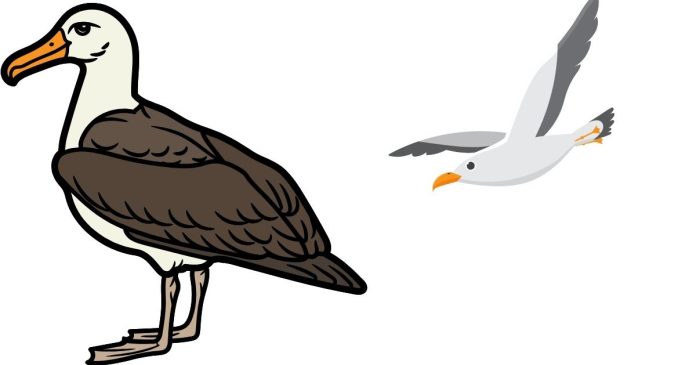Yes, seabirds are primarily carnivores, though their diet can vary depending on the species, their habitat, and the available food sources. Most seabirds are opportunistic feeders and have evolved specialized diets based on their environment and hunting skills.
Here’s a detailed breakdown of the different types of carnivorous seabirds and what they eat:
1. Types of Seabirds and Their Carnivorous Diets
1.1. Gulls (Family: Laridae):
- Diet: Gulls are known for being opportunistic feeders, and their diet can include a wide range of animal-based food. They primarily eat fish, squid, and small marine creatures, but they will also scavenge from landfills, human food waste, and even steal food from other birds.
- Examples: Herring gulls, laughing gulls, and ring-billed gulls.
1.2. Terns (Family: Sternidae):
- Diet: Terns are skilled fishers. They typically feed on small fish, including sardines, anchovies, and other schooling fish. They catch their prey by diving into the water from the air.
- Examples: Common tern, black tern, and Arctic tern.
1.3. Albatrosses (Family: Diomedeidae):
- Diet: Albatrosses are known to feed on squid, fish, and other marine creatures. They often hunt at night and use their large wingspans to cover vast distances in search of food.
- Examples: Wandering albatross, Laysan albatross.
1.4. Puffins (Family: Alcidae):
- Diet: Puffins are specialized fish-eaters. They primarily eat small fish like herring, capelin, and sand eels. Puffins are skilled divers and catch multiple fish in their beaks at once while underwater.
- Examples: Atlantic puffin, horned puffin.
1.5. Shearwaters (Family: Procellariidae):
- Diet: Shearwaters feed on fish, squid, and plankton. They dive into the ocean to catch their prey and are often found in areas with abundant marine life.
- Examples: Manx shearwater, sooty shearwater.
1.6. Petrels (Family: Procellariidae):
- Diet: Petrels feed on a variety of marine organisms, including fish, squid, and krill. They are capable of long migrations and rely heavily on the open ocean for food.
- Examples: Northern petrel, Wilson’s storm-petrel.
1.7. Cormorants (Family: Phalacrocoracidae):
- Diet: Cormorants are diving birds that feed on fish, crustaceans, and even mollusks. They are excellent swimmers and hunt underwater by chasing and catching their prey.
- Examples: Great cormorant, double-crested cormorant.
1.8. Penguins (Family: Spheniscidae):
- Diet: Penguins are strictly carnivorous and feed mainly on fish, squid, and krill. They are highly adapted for hunting in the water, using their wings as flippers to swim and catch prey.
- Examples: Emperor penguin, Adélie penguin, and chinstrap penguin.
2. Seabird Diets and Adaptations for Carnivory
Seabirds have evolved various adaptations to help them find, catch, and consume their prey, including:
- Sharp Beaks and Talons: Many seabirds have sharp, pointed beaks for catching and holding onto fish or other marine prey. For example, the tropical booby has a pointed beak that allows it to catch fish while diving.
- Diving Abilities: Seabirds like puffins, cormorants, and penguins are skilled divers, allowing them to hunt prey underwater. They have specialized wings or flipper-like structures for efficient swimming.
- Flight and Long-distance Hunting: Species like albatrosses and shearwaters can fly long distances across the ocean in search of food. Their large wingspans enable them to glide effortlessly over the water, often covering vast areas.
- Feeding Behavior: Many seabirds hunt individually by diving for fish or squid, while others may hunt in groups, particularly in the case of larger colonies of terns or gulls. Seabirds like the shearwater or petrel often scavenge for fish at the surface or even hunt in deep waters for squid.
3. Other Seabirds’ Opportunistic Feeding Habits
While most seabirds are carnivorous, some species are more opportunistic and will also consume vegetative material, such as seaweed or fruits. However, the majority of their diet consists of animal-based food, particularly marine creatures.
- Brown Pelican (Pelecanus occidentalis): Primarily fish-eating, but will occasionally consume crustaceans or small invertebrates.
- Frigatebirds (Family: Fregatidae): They are mostly carnivorous but will also take advantage of food sources like bird eggs or nestlings, particularly from other seabird colonies.
4. Summary
Seabirds are primarily carnivores and feed mainly on marine animals such as fish, squid, krill, and crustaceans. Their diets vary based on their species, and their feeding techniques are highly adapted to their marine environments, with some birds diving, others scavenging, and others flying long distances to find food.


